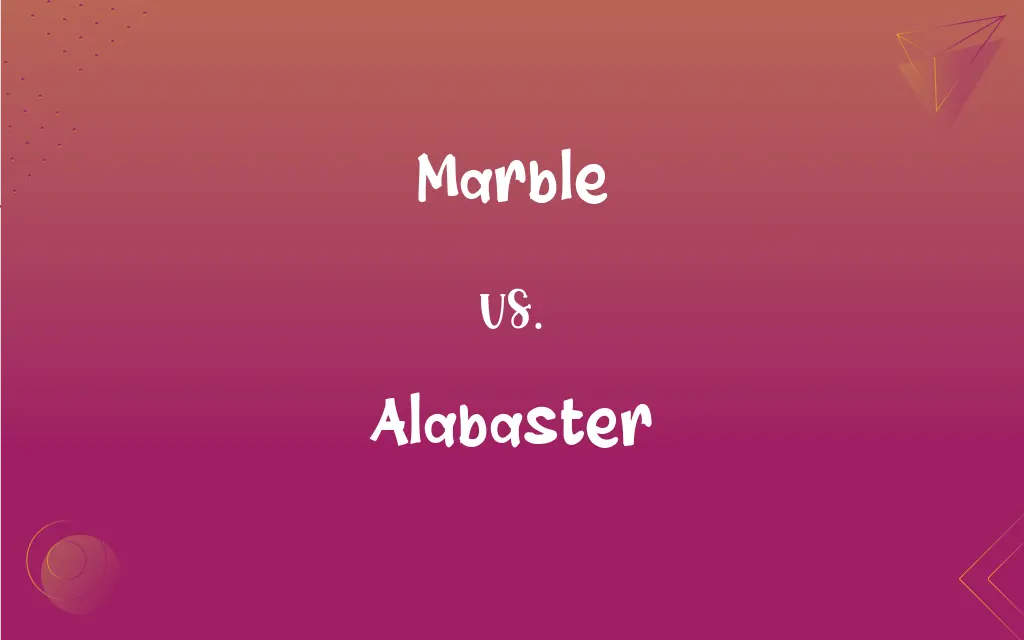Marble vs. Alabaster: What's the Difference?
Edited by Janet White || By Harlon Moss || Updated on November 7, 2023
Marble is a hard, crystalline metamorphic rock used in sculpture and architecture, while alabaster is a softer, often translucent, fine-grained stone commonly used for ornamental purposes.

Key Differences
Marble is a metamorphic rock that forms when limestone is subjected to high pressure and temperature. Its high density and crystalline structure give it a sparkling appearance and make it durable, popular for use in construction and sculpture. Alabaster, in contrast, is softer, making it easy to carve, and has a translucency that gives it a particular appeal for smaller, more intricate artistic works.
Alabaster is a mineral or rock that is soft and often used for carving, and is processed for plaster powder. Architects and artists have valued both marble and alabaster for their beauty and workability. However, marble's durability makes it more suitable for outdoor sculptures and building facades, while alabaster's softness is preferred for indoor statues and ornaments.
Marble has been a symbol of affluence and is commonly seen in grand buildings, its varieties ranging from pure white to a range of colors due to mineral impurities. Alabaster, while also prized throughout history, is less commonly used in large-scale architecture due to its softer, more pliable nature, which makes it less resistant to weathering.
The term 'marble' is often used in reference to any polished stone with a smooth, shiny surface, but true marble has a specific geological makeup, primarily consisting of recrystallized carbonate minerals. Alabaster, on the other hand, primarily consists of gypsum or calcite, which is much softer than the minerals composing marble, and has a characteristic smoothness and milky translucency.
While marble is formed from the metamorphosis of sedimentary carbonate rocks, typically limestone or dolomite rock, alabaster is formed by the evaporation of sulfide or sulfate-bearing waters. The geological processes that create marble usually occur over millions of years, while alabaster deposits can form relatively quickly in geological terms.
ADVERTISEMENT
Comparison Chart
Composition
Metamorphic rock, mainly of calcite
Soft mineral or rock, usually gypsum
Hardness
Hard and suitable for outdoor use
Softer, more suitable for indoor use
Translucency
Generally opaque
Often translucent
Use in Sculpture
Preferred for large, outdoor works
Favored for small, delicate pieces
Weather Resistance
High resistance to weathering
Low resistance, prone to weather damage
ADVERTISEMENT
Marble and Alabaster Definitions
Marble
A crystalline metamorphic rock often used for statues and buildings.
The artist chose a block of marble for his next sculpture.
Alabaster
Often white or tinted stone used in small-scale artistic applications.
He admired the alabaster figures on the mantelpiece.
Marble
A rock that undergoes metamorphism, becoming dense and polished.
Ancient architects used marble to construct enduring monuments.
Alabaster
A mineral or rock soft enough for detailed artworks and ornamental designs.
Delicate carvings were etched into the alabaster panel.
Marble
A term also used for stones with a similar appearance to true marble.
The kitchen countertops were made of cultured marble.
Alabaster
A fine-grained, translucent variety of gypsum used for carving.
The alabaster vase emitted a soft glow with the light behind it.
Marble
A durable stone used extensively in architecture and sculpture.
The marble floors of the lobby shone under the ornate chandelier.
Alabaster
Known for its smooth texture and ease of being worked into intricate shapes.
The artist preferred alabaster for his more detailed sculptures.
Marble
A stone prized for its aesthetic qualities and strength.
The marble statue stood proudly in the museum for centuries.
Alabaster
A term that can refer to both calcite and gypsum varieties.
The museum's alabaster collection included pieces from many ancient civilizations.
Marble
A metamorphic rock formed by alteration of limestone or dolomite, often irregularly colored by impurities, and used especially in architecture and sculpture.
Alabaster
A dense, translucent, white or tinted fine-grained gypsum.
Marble
A piece of this rock.
FAQs
What are common uses for marble?
Marble is used for buildings, statues, countertops, and tiles.
How are marble and alabaster different in terms of hardness?
Marble is much harder and more weather-resistant than alabaster.
What is alabaster?
Alabaster is a softer, often translucent gypsum or calcite stone used mainly for ornamental works.
Can alabaster be polished like marble?
Alabaster can be polished, but it does not achieve the same shine as marble.
Are marble and alabaster sustainable materials?
Both materials are natural, but quarrying them has environmental impacts.
What are common uses for alabaster?
Alabaster is commonly used for indoor sculptures, ornaments, and decorative items.
Is alabaster easier to carve than marble?
Yes, due to its softness, alabaster is easier to carve than marble.
Can alabaster be used outdoors like marble?
Alabaster is less durable than marble and not recommended for outdoor use.
Is alabaster considered a luxury material?
Alabaster is considered a luxury material for its beauty and ease of carving.
What is marble?
Marble is a hard, crystalline metamorphic rock typically used in construction and art.
How does the translucency of marble compare to alabaster?
Marble is usually opaque, whereas alabaster can be quite translucent.
Is marble more expensive than alabaster?
Marble can be more expensive, especially high-quality varieties.
What kind of marble is most valued?
White Carrara marble is among the most valued for its quality and purity.
How do you care for marble surfaces?
Marble surfaces should be sealed and cleaned with mild, non-acidic cleaners.
Can marble and alabaster be repaired if damaged?
Yes, both can be repaired, but the ease of repair depends on the extent of damage.
Why is marble often used in classical architecture?
Marble's durability and aesthetic appeal have made it a staple in classical architecture.
What is the geological origin of marble?
Marble is formed from limestone that has been subjected to high pressure and heat.
What is the geological origin of alabaster?
Alabaster is formed from the evaporation of mineral-rich waters.
Can marble and alabaster be synthetic?
Yes, there are synthetic versions of both, often used for decorative purposes.
How do you care for alabaster objects?
Alabaster should be dusted gently and kept away from moisture and acids.
About Author
Written by
Harlon MossHarlon is a seasoned quality moderator and accomplished content writer for Difference Wiki. An alumnus of the prestigious University of California, he earned his degree in Computer Science. Leveraging his academic background, Harlon brings a meticulous and informed perspective to his work, ensuring content accuracy and excellence.
Edited by
Janet WhiteJanet White has been an esteemed writer and blogger for Difference Wiki. Holding a Master's degree in Science and Medical Journalism from the prestigious Boston University, she has consistently demonstrated her expertise and passion for her field. When she's not immersed in her work, Janet relishes her time exercising, delving into a good book, and cherishing moments with friends and family.































































